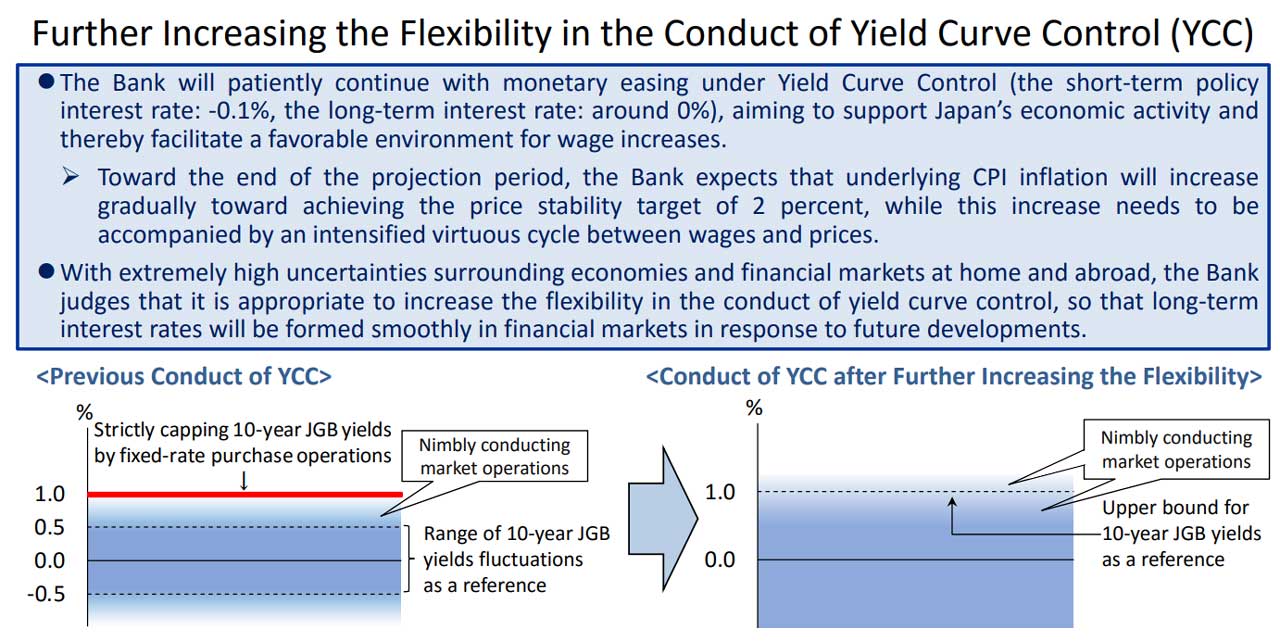일본 중앙은행인 일본은행(BOJ, Bank of Japan)이 31일 금융정책결정회의(Monetary Policy Meeting)에서 장기금리 지표인 10년물 국채 금리의 변동 폭 상한을 1%로 유지하되, 이를 어느 정도 초과하는 것도 허용하기로 결정했다.
즉 일본은행이 미국의 높은 장기 국채 금리와 환율 상승에 부담을 느껴 양적완화(量的緩和, Quantitative Easing, QE)정책 중 하나인 ‘수익률 곡선 통제(Yield Curve Control, YCC)정책‘에 수정을 가한 것이다.
 자료: BOJ(Bank of Japan)
자료: BOJ(Bank of Japan)
지난해 12월 장기금리 상한을 기존 0.25%에서 0.50%로, 그리고 올해 7월는 10년물 국채 금리 변동폭 상한을 0.5%에서 1%로 인상했다.
정도의 차이는 있겠지만 세 차례 모두 금리를 인상의 의지가 담겨 있다. 오랫동안 성장을 촉진하기 위해 사용해 온 저금리(낮은 이자율) 정책으로 인해 이제는 다른 주요 경쟁국들과의 이자율 갭이 너무 크게 벌어졌기 때문이다.
그러나 일부 전문가들은 일본은행의 이번 결정이 시장에 미치는 영향에 대해 회의적인 시각을 보이기도 했다. 특히 엔화의 가치가 미국 달러 대비 약세를 보이는 상황에서, 일본은행의 금융정책 수정이 엔화 가치의 추가 하락을 초래할 수 있다는 우려의 목소리가 나오고 있다.
참고로, 수익률 곡선 통제(YCC)는 ‘중앙은행이 장기 금리에 일정한 목표를 설정하고 이를 달성하기 위해 채권을 매수하거나 매도하는 것으로 보통은 양적완화(QE)보다 좀 더 적극적인 통화정책’이다.
사진: 일본은행, 로이터 연합뉴스
English version>>
Bank of Japan allows long-term interest rate to exceed 1% cap, could revise YCC
Japan’s central bank, the Bank of Japan (BOJ), decided at its monetary policy meeting on Jan. 31 to set an upper limit on the fluctuation of the 10-year government bond rate, a measure of long-term interest rates, at 1%, but to allow it to be exceeded to some extent.
In other words, the Bank of Japan revised the Yield Curve Control (YCC) policy, one of the QE policies, as it felt burdened by the high U.S. interest rates on long-term government bonds and rising exchange rates.
In December of last year, the Fed raised the cap on long-term interest rates from 0.25% to 0.50%, and in July of this year, it raised the cap on the 10-year Treasury rate from 0.5% to 1%.
All three hikes signaled a willingness to raise rates, albeit to varying degrees. The reason for this is that the interest rate gap with other major competitors has now widened too much due to the long-standing policy of low interest rates used to spur growth.
However, some experts were skeptical about the impact of the Bank of Japan’s decision on the markets. Especially with the yen weakening against the U.S. dollar, there are concerns that the BOJ’s monetary policy modifications could lead to a further decline in the value of the yen.
For reference, yield curve control (YCC) is “monetary policy in which a central bank sets a specific target for long-term interest rates and buys or sells bonds to achieve it, usually more aggressively than quantitative easing (QE)”.



